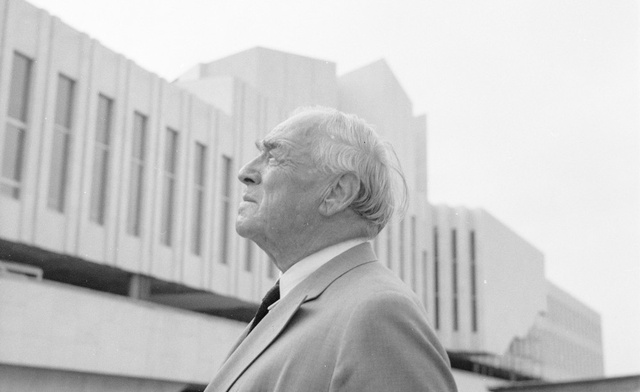Editorial: Chris Barton on male architects

Please no, not Alvar Aalto. Finnish female director Virpi Suutari’s brilliant examination, Aalto, showing here in May and June at the Resene Architecture & Design Film Festival, lays bare some uneasy home truths about the man lauded as an icon of modernism. Revelations that give pause to rethink his beautiful, organic, curving architecture, his chairs, vases, and even his tea towels.
Suutari’s coup was gaining access and permission to use love letters between Aalto and his first wife Aino, whom he married in 1924 and who died in 1949. They give unusual insight into the man behind the hero image, including his “erotic approach to life and work”. He was a philanderer. He drank. In one letter, he writes: “You need to commit a whole lot of sin before we’re even. I have sometimes picked people up on the streets.” Another letter finishes: “Then to bed. (No girls.)” He was also charismatic, gregarious, a supreme networker, an ambitious self-promoter and raconteur. He knew how to charm the press and woo the wealthy, especially the Rockefellers.
Aalto’s Dionysian limelight-hugging lifestyle is hardly unusual among male architects. Some might say it’s part of the job description. In his review of the film, the Guardian’s Oliver Wainwright wonders whether Aalto learned such behaviour from Frank Lloyd Wright. Apparently, Aalto changed completely after meeting him. “Gone was the casual Finnish country attire, replaced instead with double-breasted suits.”
Aalto isn’t alone as a master of modernism coming under scrutiny. Writing about an exhibition in 2017, Guardian critic Rowan Moore doesn’t hold back about Frank Lloyd Wright: “It is not that he was a fantasist, liar and egomaniac who left a trail of emotional destruction in his wake, nor that his buildings leaked and crumbled and went many times over budget, nor that the chairs he designed fell over and defied basic norms of comfort, nor that he wrote and spoke pure, shining, transcendent, transparent nonsense, nor that he was a hypocrite who preached democracy and freedom but flirted with tyrants such as Mussolini and Stalin…” Phew. Moore also has a crack at “two other self-mythologising, tyrant-chasing, client-exploiting giants of the 20th century, Le Corbusier and Mies van der Rohe” and their “barely habitable yet iconic houses” – Corb’s Villa Savoye and Mies’ Farnsworth House.
Much of Aalto’s early success in America was down to his 1938 exhibition, Alvar Aalto: Architecture and Furniture, at New York’s Museum of Modern Art (MoMA) organised by none other than modernism supremo Philip Johnson, the founding director of the department of architecture and design at MoMA. The gallery is currently under growing pressure to remove Johnson’s name from its galleries and titles after Harvard addressed the late architect’s legacy at the university, saying his history of racism, fascism and white supremacy had “absolutely no place in design”.
In the 1930s, Johnson worked with extreme right-wing groups in the US, promoted anti-Semitism and Nazism, and attempted to form a fascist political party. Harvard’s Graduate School of Design recently denounced its former student, saying they would not use his name to refer to a house he designed that is owned by the university. In March, MoMA temporarily covered Johnson’s name on wall signage in its architecture galleries as part of Reconstructions: Architecture and Blackness in America, an exhibition devoted to architecture and Black communities across the US and the first of its kind at the museum. The covering of Johnson’s name comes several months after an open letter by the Johnson Study Group, which claims that Johnson relied on MoMA “as a pretence to collaborate with the German Nazi party” and that he “effectively segregated the architectural collection at MoMA”, having never acquired a work by a Black architect during his time there.
In contrast with Johnson’s racism, Aalto seems guilty of little more than being a flawed, contradictory human being. Still, it’s disappointing. What Suutari’s film shows is a portrait of a marriage and a collaboration, and how symbiotically Aalto and his wives Aino and Elissa worked together. Pity that Aalto took all the credit. Thankfully, the film gives some redress, showing Aino having a strong sense of social responsibility and a point of view deeply respected by Alvar. One of the film’s narrators describes her as the “necessary balancing element” in Aalto’s otherwise “bohemian and erratic” life.
As Wainwright points out, Aino Aalto was both a qualified architect and a trained carpenter, who designed many of the Aalto buildings’ interiors and was involved in creating the pioneering bentwood furniture that made Aalto a famous name internationally. She was the chief designer and managing director of Artek, the company founded in 1935 that produced their range of textiles, lamps and glassware. “That ribbed Ikea tumbler in your kitchen cupboard? It’s an Aino Aalto knock-off,” says Wainwright.
One of the film’s narrators sums up the dilemma: “Regardless of how the drawings are signed, they clearly worked as a team. We’ll never know where the division is between the two.” True but, as Suutari shows, we now know Aino was, in fact, a crucial part of the Aalto oeuvre and never received that credit.
Aalto addresses this lack of recognition for female architects worldwide, especially when they are associated with great men, as do initiatives like the Couplings’ Tactic, which critically maps architectural couplings, raising questions about the intimate and creative collaboration behind architectural legacies. There’s a wider question, too, about the prevailing view that great architecture is produced by a great genius, predominantly male, when we all know that architecture has been and always will be a collaborative act. And a talent of the order of Aino Aalto should always have been recognised. Credit where credit is due.









